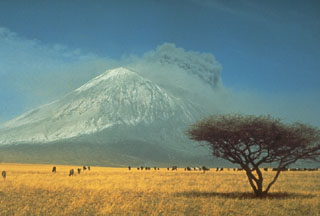Report on Ol Doinyo Lengai (Tanzania) — March 1983
Scientific Event Alert Network Bulletin, vol. 8, no. 3 (March 1983)
Managing Editor: Lindsay McClelland.
Ol Doinyo Lengai (Tanzania) Reported February lava flow not found; strong gas emission ends; small ash-poor plumes
Please cite this report as:
Global Volcanism Program, 1983. Report on Ol Doinyo Lengai (Tanzania) (McClelland, L., ed.). Scientific Event Alert Network Bulletin, 8:3. Smithsonian Institution. https://doi.org/10.5479/si.GVP.SEAN198303-222120
Ol Doinyo Lengai
Tanzania
2.764°S, 35.914°E; summit elev. 2962 m
All times are local (unless otherwise noted)
Marie Benson reported that Ol Doinyo Lengai erupted 1 and 9 January, and 17 and 20 February but not since then. During the 20 February eruption, lava was flowing toward Lake Natron (N of the volcano). Andrew Stirrat, and the Outward Bound expedition of which he was co-leader, were N and W of the volcano 13-16 March. They saw small gray plumes emerging from the summit area on 13-14 March, and the morning of the 15th but none later that day or on the 16th. Clear views of the summit were obtained during the evening of 14 March and throughout the night of 15-16 March but no glow was evident. An apparent thin layer of ash on the upper N flank was visible through binoculars but no fresh ash was recognized in the area visited by the expedition, which approached to within 2.5 km of the foot of the volcano, nor did they observe any new lava. A local guide who was near the volcano 7-10 March reported that the air was hazy and smelly and caused chemical burns on his arms after 6 hours of exposure, the only time he had encountered such problems in the previous 3 months. Madelon Kelly and others visited the area a few km E and N of the volcano 15 March but observed neither lava nor any apparent eruptive activity. Their photographs showed no plumes.
Geological Summary. The symmetrical Ol Doinyo Lengai is the only volcano known to have erupted carbonatite tephras and lavas in historical time. The prominent stratovolcano, known to the Maasai as "The Mountain of God," rises abruptly above the broad plain south of Lake Natron in the Gregory Rift Valley. The cone-building stage ended about 15,000 years ago and was followed by periodic ejection of natrocarbonatitic and nephelinite tephra during the Holocene. Historical eruptions have consisted of smaller tephra ejections and emission of numerous natrocarbonatitic lava flows on the floor of the summit crater and occasionally down the upper flanks. The depth and morphology of the northern crater have changed dramatically during the course of historical eruptions, ranging from steep crater walls about 200 m deep in the mid-20th century to shallow platforms mostly filling the crater. Long-term lava effusion in the summit crater beginning in 1983 had by the turn of the century mostly filled the northern crater; by late 1998 lava had begun overflowing the crater rim.
Information Contacts: M. Benson, USAID, Arusha; D. Miller, U.S. Embassy, Dar es Salaam; A. Stirrat, Outward Bound; M. Kelly, Tyrone, PA.

